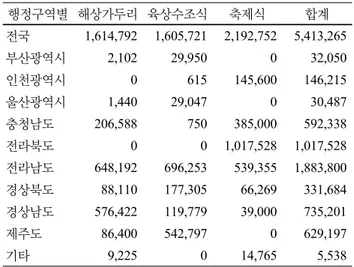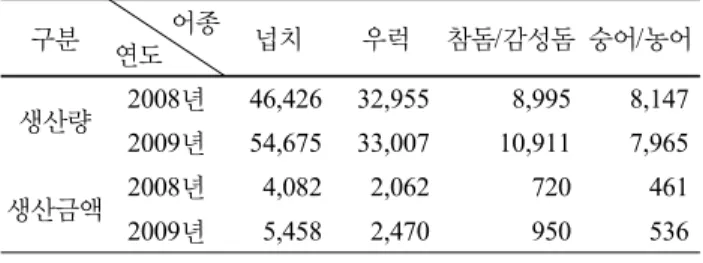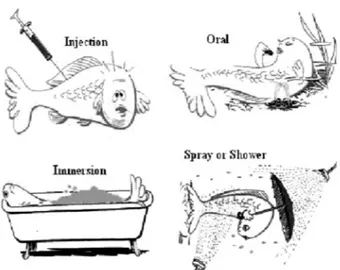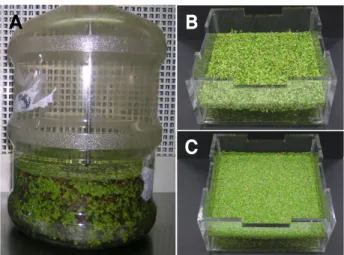E.-J. Park ・ M. N. Kim ・ J. Y. Park ・ J. H. Cha ・ H.-J. Chung ( ) (주) 젠닥스
(Gendocs Inc. 544-1 B-Station 3F Bongmyung-Dong, Yuseong-Gu, Daejeon 305-301, Korea)
e-mail: hwajee@gendocs.co.kr
어류 경구백신 현황과 전망
박은준 ・ 김미나 ・ 박주영 ・ 차재호 ・ 정화지
Edible vaccine for aquacultured fish: present and prospect
Eun-Joon Park, Mina Kim, Ju Young Park, Jae Ho Cha, Hwa-Jee Chung
Received: 4 August 2010 / Accepted: 17 August 2010
ⓒKorean Society for Plant Biotechnology
Table 1 시도군별 양식방법에 따른 전체 사육시설 면적 현황 (단위: m2)
행정구역별 해상가두리 육상수조식 축제식 합계
전국 1,614,792 1,605,721 2,192,752 5,413,265
부산광역시 2,102 29,950 0 32,050
인천광역시 0 615 145,600 146,215
울산광역시 1,440 29,047 0 30,487
충청남도 206,588 750 385,000 592,338
전라북도 0 0 1,017,528 1,017,528
전라남도 648,192 696,253 539,355 1,883,800 경상북도 88,110 177,305 66,269 331,684 경상남도 576,422 119,779 39,000 735,201
제주도 86,400 542,797 0 629,197
기타 9,225 0 14,765 5,538
(자료 : 통계청 2010. 3. 11) Abstract As the capture fishing industry has declined, the
aquaculture industry has become an important source of seafood. With this tendency all fish farming will be per- formed by large-scale farms where the fish are cultivated in much high density and as a result the incidence of infectious diseases increases. Therefore, vaccination has become an increasingly important part of aquaculture as a cost effective method of controlling various diseases. The early fish vac- cines were the formalin inactivated bacteria or virus cul- tures, which were administered by either immersion or injection. Recombinant DNA biotechnology allowed us to develop orally administrated DNA and recombinant vac- cines. In terms of the manufacturing process and cost, Lemna and Spirodela is the most efficient and reliable plant expression system for the production of edible vaccine.
서 론
수산 자원이 풍부한 우리나라에서는 생선 섭취가 증가 하고 있고 활어에 대한 선호도가 높은 편이다. 특히 잡는 어업으로부터 키우는 양식어업으로 전환함에 따라 양식 업은 매년 그 기술이 급속히 발달하여 지금은 넙치, 조피 볼락, 농어, 돔류 등의 해수어와 뱀장어, 송어류 등의 담 수어 양식이 가능하게 되었다. 국내 양식 어류 생산량은 해마다 증가하여, 2010년 3월 현재 양식 수산물의 총 생 산량은 3,481,384 M/T이며 이중 활어 생산량은 1,804,808
M/T에 이른다. 남해안과 서해안 등에 집중되어 있는 전 체 양식장 면적은 해상가두리, 육상수조식 및 축제식을 합쳐 약 486.1 ha에 달하며, 이중 육상수조식은 전체 양식 면적의 42%에 이른다 (Table 1). 2009년도 어종별 생산량 은 넙치가 54,675톤으로 전체 생산량의 49.9%를 차지하 고, 우럭 33,007톤 (30.1%), 참돔 9,223톤 (8.4%) 순으로 전 체 생산금액은 9,816 억원에 이른다 (Table 2).
국내 양식장의 규모가 점차적으로 대형화함으로써 높 은 밀집사육과 수질의 저하로 어류 감염성 질병 발생율 이 증가하는 추세이다. 국내 양식어류 중에서 생산량이 가장 많은 넙치의 경우 문제시되고 있는 질병으로는 연 쇄구균증, 에드워드증, 비브리오증, 활주세균증 등의 세 균성질병과 이리도바이러스, 림포시스티스 바이러스, 버 나바이러스, 노다바이러스와 같은 바이러스질병 등이 보 고되고 있다 (Table 3). 어류의 세균성질병 발생을 막기 DOI:10.5010/JPB.2010.37.3.269
Review
Table 2 주요 양식어종의 연도별 생산량 및 생산금액 (단위: 톤, 억원)
구분 어종
연도 넙치 우럭 참돔/감성돔 숭어/농어
생산량 2008년 46,426 32,955 8,995 8,147 2009년 54,675 33,007 10,911 7,965
생산금액 2008년 4,082 2,062 720 461
2009년 5,458 2,470 950 536
(자료 : 통계청 2010. 3. 11)
Table 3 해산어류에서 발생되는 감염성 질병
질병 감염균/바이러스 감염어종
에드와드병 Edwardsiella tarda 넙치 연쇄구균증 Streptococcus iniae
S. parauberis 넙치 비브리오증 V. harveyi
V. ichthyoenteri 넙치 바이러스성
출혈성패혈증 VHSV 넙치
림포시스티스병 LCDV 넙치, 방어, 농어 등 해
산어종
이리도바이러스 iridovirus 돌돔, 참돔, 감성돔, 농어 버나바이러스 virnavirus 넙치, 조피볼락, 방어
상피증생증 herpesvirus 넙치, 조피볼락
랩도바이러스 rhabdovirus 넙치, 방어
신경괴사증 nodavirus 능성어, 조피볼락, 넙치, 민어
(자료. 바이엘화학 2005, 국립수산과학원)
위해서 항생제가 사용되지만 바이러스성 질병은 수평감 염뿐만 아니라 수정란에 의한 수직감염이 되기 때문에 한번 발생되면 치료가 불가능하고 대량폐사를 일으키는 경우가 많다. 특히 8-9월 고수온 환경이 되면 용존산소가 감소함에 따라 바이러스 발병률이 높아지므로 예방차원 의 방역조치가 중요하다.
양식 어류의 감염 질병을 방지하기 위한 항생제의 지 속적인 사용은 내성균을 유발시키며 환경 오염 등의 문 제를 일으키고 있어 이에 대한 대책으로 수산 선진국인 노르웨이, 영국, 미국, 캐나다 등에서는 항생제 사용을 제 한하는 대신 백신 개발을 적극적으로 추진하고 있다. 최 초의 어류백신으로는 1942년 Aeromonas salmonicida를 포 르말린에 불활화한 백신으로 실험실내에서 사용한 예가 있다. 1976년 미국에서 포르말린으로 처리한 비브리오 (Vibrio anguillarum) 침지백신이 개발되어 1980년대 초부 터 양식 산업에 적용되기 시작하였다. 이후 부스럼병, 에 드와드병, 콜룸나리스병, 비브리요병, 연쇄구균증 및 구 적병 백신 등이 개발되어 유럽, 미국, 일본, 캐나다 등에 서 상용화되었다 (수산동물방역센터 자료 2007). 국내에
서 사용이 승인되거나 개발된 수산용 백신은 연쇄구균 증, 에드와드병, 이리도바이러스 예방백신이며, 최근 넙 치의 연쇄구균증의 원인균인 베타-용혈성의 스트렙토코 커스 이니에 (Streptococcus iniae)와 감마-용혈성의 스트렙 토코커스 파라우베러스 (Streptococcus parauberis) 균주를 불활성화시킨 혼합 주사백신이 국내에서 개발되었다 (http://
kodc.nfrda.re.kr/bbs?id=jj_insmaterial). 향후 국내외 양식산 업의 확대에 따라 백신의 수요는 점차 증가할 것으로 예 상되며, 이에 따라 우리나라도 백신 개발에 집중적인 투 자가 필요하다.
어류 백신 개발 현황 및 투여법
어류백신의 종류는 크게 불활화백신 (inactivated vaccines), 약독화백신 (live attenuated vaccines), DNA 백신, 재조합단백 질백신 (recombinant vaccines) 등이 있다 (RUMA guidelines 2006; Toranzo et al. 2009). 불활화백신은 주로 박테리아나 바이러스를 포르말린이나 특정 화학품으로 처리한 것으 로 항원보강제 (adjuvant)와 함께 투여해야 면역 효과가 있는 것으로 알려져 있다 (Caipang et al. 2006a). 약독화백 신 경우는 병원성을 일으키지 않고 숙주 세포내에서 면 역반응을 유도하며 항체를 생산하는 장점이 있으나, 간 혹 질병을 유발할 가능성이 있다. DNA 백신은 면역을 유 도할 수 있는 항원단백질의 유전자를 직접 어류에 투여 하여 어류의 세포내에서 항원단백질이 발현됨으로써 면 역반응을 유도하는 방법이다. 대부분의 DNA 백신은 항 원단백질 유전자 발현을 위해 어류 cytomegalovirus (CMV) 혹은 β-actin 프로모터를 이용한다 (Caipang et al. 2006b;
Kurath 2008; Lorenzen and LaPatra 2005). DNA백신은 항원 보강제를 사용하지 않는 대신 DNA 플라스미드 내에 CpG-S 혹은 CpG-N motif를 포함시켜 면역을 유도한다 (Chen et al. 2007; Jorgensen et al. 2003; Pedersen et al. 2006).
아울러 항원단백질 전체 혹은 일부를 대장균이나 효모 등에서 대량 생산하여 투여하는 재조합단백질 백신도 있 다 (Fu et al. 2008; Jha et al. 2007; Ning et al. 2009; Poobalane et al. 2010; Sommerset et al. 2005; Zhu et al. 2009) 백신을 투여하는 방법으로는 크게 주사법, 침지법 및 경구투여법 등이 있다 (Fig. 1). 이 중에서 주사법은 투여 량이 정확하고 백신의 양도 적게 소요되며 또한 면역보 강제의 첨가가 가능하여 어류에 확실한 면역능력을 부여 하는 장점이 있지만, 노동력이 많이 소요되는 단점이 있 어 실용화하기가 어려운 단점이 있다. 침지법에는 고농 도로 백신이 첨가된 용기에 어류를 단시간 침지시키는 표준법과, 사육수조에 백신을 직접 저농도로 첨가하여 침지시키는 저농도법이 있다. 표준법은 소요되는 백신의 양은 적지만 처리작업이 번거로운 반면, 저농도법은 작
Fig. 1 Fish vaccination strategies. Cartoons courtesy of Cor Lamers. Wageningen University
업이 간편한 대신 백신 사용량이 많다. 주사법과 표준침 지법은 처리시 스트레스를 많이 받기 때문에 어린 어류 에게는 사용하기 어렵다. 경구투여법은 사료에 백신을 혼합한 후에 사용하므로 투여방법이 가장 간편하지만 다 량의 백신을 장기간 투여하여야 하며 예방효과도 떨어지 는 단점이 있다 (문진산 외 2007; Komar et al. 2004). 따라 서 어류의 스트레스를 줄이는 동시에 백신의 생산비용, 대량 생산 시스템 및 안전한 저장과 운반 시스템 등을 고 려한다면 경구백신의 단점을 보완한 백신을 개발하는 것 이 한층 효과적이다.
어류 경구백신 개발
어류 경구백신은 사료와 함께 투여되도록 제조하는 것 이 바람직하며 일반적으로 대장균, 효모 및 바실러스와 같은 미생물에서 대량생산하여 사료와 함께 투여한다 (Allnutt et al. 2007; Fu et al. 2008; Lin et al. 2005). 사료형태 로 제조할 경우 백신 항원을 식용 오일을 사용하여 사료 표면에 코팅을 하거나, 사료배합재료와 함께 혼합한 후 펠렛으로 만든다. 그러나 펠렛 과정 동안 고온과 고압에 도 백신항원이 안정한 제조 조건을 고려해야만 하는 문 제점이 있다. 또한 pH가 산성이며 많은 protease, nuclease 가 존재하는 어류 소화관의 전장 (前腸)을 통과하여 후 장(後腸) 근처에 있는 면역세포에 의해 인식될 때까지 경구투여된 항원이 안정한 형태로 운반될 수 있는 기술 이 필요하다 (RUMA guidelines 2006).
주로 주사법으로 투여를 하던 DNA백신을 경구투여가 가능하도록 DNA 백신운반 시스템 개발 연구가 최근 활 발하게 진행되고 있다. Rajeshkumar 등 (2008)은 새우의 white spot syndrome virus (WSSV)의 VP28 유전자를 pcDNA 3.1 진핵세포 발현벡터로 도입하여 키토산 나노입자 형
태로 만든 후 이를 사료배합재료와 혼합하여 제조한 백 신을 경구투여 하였다. 이 연구결과에 따르면 VP28 유전 자가 내장, 아가미, 간췌장, 지느러미 등의 조직에서 경구 투여 후 30일간 유지되었으며 공격접종 시 약 65%의 생 존율을 보였다. 키토산으로 캡슐화한 LCDV의 캡시드 단 백질 유전자 플라스미드를 도다리에 경구투여 하면 캡시 드 단백질 유전자가 10-90일까지 조직에 남아 있었으며, 또한 공격접종 후 경구백신을 투여 받은 실험구는 50-85%
생존율을 보였다는 연구결과도 보고되었다 (Tian et al.
2008). 키토산 이외에도 항원 DNA를 alginate로 캡슐화한 백신이 경구투여된 후에도 그 면역효과를 지속한다는 연 구결과 또한 보고되었다 (Heras et al. 2010; Rodrigues et al.
2006; Romalde et al. 2004; Tian et al. 2008). 이상의 연구결 과로 키토산과 alginate에 의해 항원이 소화관을 통과하는 동안 안전하게 보호된다는 것을 알 수 있다. 또한 Tian 등 (2008)은 alginate 입자가 혈액을 통해 면역조직으로 확산 되어 항체 생산을 유도한다는 것을 제시함으로써 경구백 신의 단점을 보완할 계기를 마련하였다. 그러나 어류 경 구백신 개발에 대한 많은 연구가 진행되었음에도 불구하 고 현재 상용화되고 있는 경구백신은 메기의 에드와드 병, 새우와 연어의 비브리오병, 방어 및 방어속의 연쇄구 균증, 그리고 잉어과 어류 (tilapia) 연쇄구균증의 경구백 신 뿐이며, 현재까지 개발 상용화된 재조합단백질 항원 경구백신 제품은 없다 (www.spaquaculture.com.).
식물발현시스템을 이용한 어류 경구백신개발
최근 식물을 이용한 외래단백질 생산시스템이 개발되 기 시작하여 인체 혹은 동물 질병 치료를 위한 항체 및 백신 등을 생산하려는 연구가 활발하게 진행되고 있다.
동물세포나 미생물 발현시스템과는 달리 식물 발현시스 템으로 생산된 외래단백질은 분리 정제과정 없이도 바 로 경구투여용으로 사용할 수 있어 경제적이고 편리한 장점을 지니고 있다 (Aviezer et al. 2009; Davoodi-Semiromi et al. 2010; Floss et al. 2007; Floss et al. 2010; Frutos et al.
2008; Lai et al. 2010; Lombardi et al. 2009; Martinez et al.
2010; Medrano et al. 2010; Nochi et al. 2009; Shaaltiel et al.
2007; Wu et al. 2009).
어류 경구백신용 항원단백질을 발현하는 타겟 식물로 는 주로 벼, 옥수수, 상치, 토마토 및 당근 등이 있으나 좀개구리밥 (Lemna)과 개구리밥 (Spirodela)만큼 매력적인 식물은 없다. 좀개구리밥과 개구리밥 (이하 개구리밥)은 단자엽인 Lemnaceae에 속하며 잎과 줄기가 미분화된 엽 상체 (frond)와 뿌리로 구성되어 있다. 개구리밥은 종자로 번식하기보다는 대부분 모엽상체로부터 새로운 엽상체 를 형성하는 영양번식 방법으로 개체를 증식하며 생육환
A B
C
Fig. 2 Large-scale liquid culture of Lemna and Spirodela. A.
Spirodela cultivated in 20L aseptic container. B and C. Spirodela and Lemna cultivated in 5L aseptic container, respectively
경이 불리하면 잠아 (turion)를 형성한다 (Stomp 2005). 생 육조건과 종에 따라 차이가 있지만 증식속도가 매우 빨 라 1-2일 내에 두 배로 증식하여, 최적 액체배양 조건하 에서 10-20개의 엽상체로부터 2-3주일 동안 생중량 700-900 g/L까지 배양이 가능하다 (Fig. 2). 개구리밥은 배양배지 조성이 매우 간단하고 비용이 저렴하며 또한 무균상태로 대량배양 할 수 있는 장점이 있다. 또한 아시아지역에서 는 개구리밥을 동물들의 사료로 사용하기도 하는데, 이 러한 특징으로 인해 어류 백신항원을 발현한 후 사료형 태로 제조하면 경구투여가 가능할 것이다.
개구리밥이 지니고 있는 여러 장점에도 불구하고 개구 리밥 발현시스템을 이용한 고부가가치 단백질 및 항체 등을 생산하는 연구는 현재 극히 제한적이다 (Vunsh et al.
2007; Rival et al. 2008; Yamamoto et al. 2001; Stomp et al.
2004). 그 주요 원인은 개구리밥의 형질전환 효율이 매우 낮기 때문일 것이다. 국내에서는 (주)젠닥스가 어류 바이 러스 예방 백신을, 한국생명공학연구원은 고부가가치 단 백질을 생산하는 연구를 수행하고 있다. 국외의 경우 Biolex Therapeutics 사가 개구리밥 발현시스템 (LEX sys- tem)으로 치료용 단백질인 인터페론 알파 (Locteron), 혈 전용해제인 Recombinant Plasmin (BLX-155) 및 Anti- CD20 antibody (BLX-301)을 개발하였고, 개발된 Locteron은 2005 년에 인체 임상 1상을 마치고 현재 임상 2상 시험을 수행 중이다 (http://www.pharmaceuticaltechnology.com/projects/biolex/).
어류 경구백신의 향후 전망
인체 혹은 동물 임상실험에 비해 비교적 짧은 시간과 임상동물을 손쉽게 구할 수 있다는 점에서 단기간 내에 상용화가 가능한 식물유래 경구백신으로는 어류 질병예
방 백신일 것이다. 물론 어류 백신제조를 위해서는 복잡 한 과정이 요구된다. 즉 질병 원인체의 특성을 고려하여 백신 종류와 적용 방법을 결정하여야 하며, 그 후 공격접 종 모델을 개발하고, 시험백신 개발 및 테스트를 거친 후 백신을 생산하는 과정을 거친다. 또한 백신의 제조 승인 을 받기 위해서는 실험실과 야외 양어장에서 유효성, 안 전성 및 안정성 (유효기간) 평가를 받아야 한다. 기업의 경우는 백신 개발 전에 면밀한 사업성 검토를 필요로 하 며, 백신 개발 후에는 제품 출시 및 마케팅 등의 준비가 필요하다. 이러한 과정을 거쳐 백신을 상용화하기까지는 약 5년 정도의 기간이 소요된다 (어류백신 품질관리 지 침서 2007).
지금까지 상용화된 어류 백신의 대부분은 북유럽, 칠 레, 캐나다 및 미국의 대단위 양식연어와 송어 질병예방 백신들이며, 주로 주사 혹은 침지법으로 투여하는 불활 화, 약독화 백신에 국한되어 있다. 최근 해수어, 담수어 및 열대어를 포함한 양식관상어 시장이 우리나라뿐만 아 니라 전 세계적으로 급성장 하는 추세에 있다. 세계 관상 어 시장규모는 2010년 기준 약 25조원 규모로 추정되며 유통되는 관상어는 약 2,000여종으로 그 종류가 다양하다 (http://blog.daum.net/sciensea/206). 향후 어류 경구백신 분야 에 있어 어류질병 조기진단 시장뿐만 아니라 관상어 질 병백신 시장을 함께 고려한다면 그 시장성과 연구방향은 새롭게 조명될 필요가 있다.
사 사
본 연구는 농림수산식품부 농림기술개발사업 (108166-03;
609004-05) 및 중소기업청 신기술사업화지원사업의 지원 에 의해 수행되었습니다.
인용문헌
Allnutt FC, Bowers RM, Rowe CG, Vakharia VN, LaPatra SE, Dhar AK (2007) Antigenicity of infectious pancreatic necro- sis virus VP2 subviral particles expressed in yeast. Vaccine 25:4880-4888
Aviezer D, Brill-Almon E, Shaaltiel Y, Hashmueli S, Bartfeld D, Mizrachi S, Liberman Y, Freeman A, Zimran A, Galun E (2009) A plant-derived recombinant human glucocerebrosidase enzyme-a preclinical and phase I investigation. PLoS One 4(3):e4792
Caipang CMA, Hirono I, Aoki T (2006a) Immunogenicity, reten- tion and protective effects of the protein derivatives of formalin- inactivated red seabream iridovirus (RSIV) vaccine in red seabream, Pagrus major. Fish Shellfish Immunol 20:596-609 Caipang CMA, Takano T, Hirono I, Aoki T (2006b) Genetic vac-
cines protect red seabream, Pagrus major, upon challenge with red seabream iridovirus (RSIV). Fish Shellfish Immunol 21:130-138
Chen Y, Xiang LX, Shao, JZ (2007) Construction of a recombinant plasmid containing multi-copy CpG motifs and its effects on the innate immune responses of aquatic animals. Fish Shell- fish Immunol 23:589-600
Davoodi-Semiromi A, Schreiber M, Nalapalli S, Verma D, Singh ND, Banks RK, Chakrabarti D, Daniell H (2010) Chloroplast- derived vaccine antigens confer dual immunity against chol- era and malaria by oral or injectable delivery. Plant Biotechnol J 8:223-242
Floss DM, Falkenburg D, Conrad U (2007) Production of vaccines and therapeutic antibodies for veterinary applications in transgenic plants:an overview. Transgenic Res 16:315-332 Floss DM, Schallau K, Rose-John S, Conrad U, Scheller J. (2010)
Elastin-like polypeptides revolutionize recombinant protein expression and their biomedical application. Trends Biotechnol 28:37-45
Frutos R, Denise H, Vivares C, Neuhaus JM, Vitale S, Pedrazzini E, Ma J, Dix P, Gray J, Pezzotti M, Conrad U, Robinson D (2008) Pharmaceutical proteins in plants. A strategic genetic engineering approach for the production of tuberculosis antigens. Ann N Y Acad Sci 1149:275-280
Fu LL, Li WF, Du HH, Dai W, Xu ZR (2008) Oral vaccination with envelope protein VP28 against white spot syndrome virus in Procambarus clarkii using Bacillus subtilis as delivery vehicles. Lett Appl Microbiol 46:581-586
de las Heras AI, Saint-Jean SR, Pérez-Prieto SI (2010) Immuno- genic and protective effects of an oral DNA vaccine against infectious pancreatic necrosis virus in fish. Fish Shellfish Immunol 28:562-570
Jha RK, Xu ZR, Bai SJ, Sun JY, Li WF, Shen J (2007) Protection of Procambarus clarkii against white spot syndrome virus using recombinant oral vaccine expressed in Pichia pastoris.
Fish Shellfish Immunol 22:295-307
Jorgensen JB, Johansen LH, Steiro K, Johansen A (2003) CpG DNA induces protective antiviral immune responses in Atlantic salmon (Salmo salar L.). J Virol 77:11471-11479 Komar C, Enright WJ, Grisez L, Tan Z (2004) Understanding fish
vaccination. AQUA Culture AsiaPacific Magazine Nov/Dec Kurath G (2008) Biotechnology and DNA vaccines for aquatic
animals. Rev Sci Tech 27:175-196
Lai H, Engle M, Fuchs A, Keller T, Johnson S, Gorlatov S, Diamond MS, Chen Q (2010) Monoclonal antibody produced in plants efficiently treats West Nile virus infection in mice.
Proc Natl Acad Sci USA 107:2419-2424
Lin JH, Yu CC, Lin CC, Yang HL (2005) An oral delivery system for recombinant subunit vaccine to fish. Dev Biol (Basel) 121:175-180
Lombardi R, Circelli P, Villani ME, Buriani G, Nardi L, Coppola V, Bianco L, Benvenuto E, Donini M, Marusic C (2009) High-level HIV-1 Nef transient expression in Nicotiana benthamiana using the P19 gene silencing suppressor protein of Artichoke Mottled Crinckle Virus. BMC Biotechnol 9:96
Lorenzen N, LaPatra SE (2005) DNA vaccines for aquacultured fish. Rev Sci Tech 24:201-213
Martinez CA, Topal E, Giulietti AM, Talou JR, Mason H (2010) Exploring different strategies to express Dengue virus envel- ope protein in a plant system. Biotechnol Lett 32:867-875 Medrano G, Dolan MC, Stephens NT, McMickle A, Erf G, Radin
D, Cramer CL (2010) Efficient plant-based production of chicken interleukin-12 yields a strong immunostimulatory cytokine. J Interferon Cytokine Res 30:143-154
Ning JF, Zhu W, Xu JP, Zheng CY, Meng XL (2009) Oral delivery of DNA vaccine encoding VP28 against white spot syndrome virus in crayfish by attenuated Salmonella typhimurium.
Vaccine 27:1127-1135
Nochi T, Yuki Y, Katakai Y, Shibata H, Tokuhara D, Mejima M, Kurokawa S, Takahashi Y, Nakanishi U, Ono F, Mimuro H, Sasakawa C, Takaiwa F, Terao K, Kiyono H (2009) A rice-based oral cholera vaccine induces macaque-specific systemic neutralizing antibodies but does not influence pre-existing intestinal immunity. J Immunol 183:6538-6544 Pedersen GM, Johansen A, Olsen RL, Jorgensen JB (2006) Stimula-
tion of type I IFN activity in Atlantic salmon (Salmo salar L.) leukocytes:synergistic effects of cationic proteins and CpG ODN. Fish Shellfish Immunol 20:503-518
Poobalane S, Thompson KD, Ardo L, Verjan N, Han HJ, Jeney G, Hirono I, Aoki T, Adams A (2010) Production and efficacy of an Aeromonas hydrophila recombinant S-layer protein vaccine for fish. Vaccine 28:3540-3547
Rajeshkumar S, Venkatesan C, Sarathi M, Sarathbabu V, Thomas J, Basha A, Hameed ASS (2008) Oral delivery of DNA con- struct using chitosan nanoparticles to protect the shrimp from white spot syndrome virus (WSSV). Fish Shellfish Immunol 26:429-437
Rival S, Winsniewski J-P, Langlais A, Kaplan H, Freyssinet G, Vancanneyt G, Vunsh R, Perl A, Edelman M (2008) Spirodela (duckweed) as an alternative production system for pharma- ceuticals:a case study, aprotinin. Transgenic Res 17:503-513 Rodrigues AP, Hirsch D, Figueiredo HCP, Logato PVR, Moraes
AM (2006) Production and characterisation of alginate microparticles incorporating Aeromonas hydrophila designed for fish oral vaccination. Process Biochem 41:638-643 Romalde J, Luzardo-Alvárez A, Ravelo C, Toranzo AE, Blanco-
Méndez J (2004) Oral immunization using alginate microparticles as a useful strategy for booster vaccination against fish lactoccocosis. Aquaculture 236:119-129
RUMA guidelines (2006) Responsible use of vaccines and vacci- nation in fish production. Supported by the National Office of Animal Health (NOAH)
Shaaltiel Y, Bartfeld D, Hashmueli S, Baum G, Brill-Almon E, Galili G, Dym O, Boldin-Adamsky SA, Silman I, Sussman JL, Futerman AH, Aviezer D (2007) Production of glucocerebrosidase with terminal mannose glycans for enzyme replacement therapy of Gaucher's disease using a plant cell system. Plant Biotechnol J 5:579-590
Sommerset I, Skern R, Biering E, Bleie H, Fiksdal IU, Grove S, Nerland AH (2005) Protection against Atlantic halibut
nodavirus in turbot is induced by recombinant capsid protein vaccination but not following DNA vaccination. Fish Shellfish Immunol 18:13-29
Stomp A-M (2005) The duckweeds:a valuable plant for bio- manufacturing. Biotechnol Annu Rev 11:69-99
Stomp A-M, Dickey L, Gasdaska J (2004) Expression of biologi- cally active polypeptide in duckweed. US patent 6815184 Tian J, Yu J, Sun X (2008) Chitosan microspheres as candidate
plasmid vaccine carrier for oral immunisation of Japanese flounder (Paralichthys livaceus). Vet Immnol Immunopathol 126:220-229
Toranzo AE, Romalde JL, Magariňos B, Barja JL (2009) Present and future of aquaculture vaccines against fish bacterial dis- eases. Opinions Méditerranéennes, A 86:155-176
Vunsh R, Li J, Hanania U, Edelman M, Flaishman M, Perl A,
Winsniewski J-P, Freyssinet G (2007) High expression of transgene protein in Spirodela. Plant Cell Rep 26:1511-1519 Wu H, Scissum-Gunn K, Singh NK, Giambrone JJ (2009) Toward the development of a plant-based vaccine against reovirus.
Avian Dis 53:376-381
Yamamoto YT, Rajbhandari N, Lin X, Bergamann BA, Nishimura Y, Stomp A-M (2001) Genetic transformation of duckweed Lemna gibba and Lemna minor. In Vitro Cell Dev Biol 37:349-353
Zhu F, Du H, Miao ZG, Quan HZ, Xu, ZR (2009) Protection of Procambarus clarkii against white spot syndrome virus using inactivated WSSV. Fish Shellfish Immunol 26:685-690 문진산, 장환, 김지연, 정병렬, 김연희, 조성준, 최준구, 손성
완, 정태성 (2007) 어류 백신 품질관리 지침서. 국립수의 과학검역원



